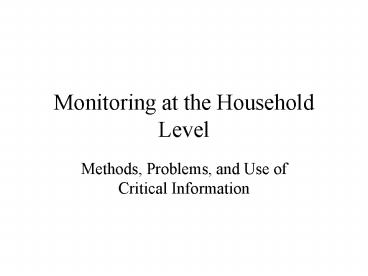Monitoring at the Household Level PowerPoint PPT Presentation
1 / 23
Title: Monitoring at the Household Level
1
Monitoring at the Household Level
- Methods, Problems, and Use of Critical Information
2
A Simplified Conceptual Outline Where does this
information fit?
- Provision of services Adequately iodized salt
must be available in the marketplace - Utilization of services Consumers must be aware
of the importance, and use iodized salt - Coverage An adequate proportion of the
population must consistently use iodized salt - Impact Periodic measurement should show
adequate iodine intake as measured by urinary
iodine
3
Salt Production, Importation, and Distribution
Internal and External Monitoring
Provision of services
4
Salt Production, Importation, and Distribution
Internal and External Monitoring
Insures that salt available to population meets
government legal requirements regarding iodine
content
5
Use of Iodized Salt, Awareness, Cost And
Cultural Habits
Utilization of services
6
Use of Iodized Salt, Awareness, Cost And
Cultural Habits
Provides an understanding of constraints to use
of iodized salt that may ultimately affect
coverage
7
Household Use of Iodized Salt
Coverage
8
Household Use of Iodized Salt
Provides a quantitative measure of household use,
and can confirm adequacy of iodine content
throughout distribution
9
Iodine Status of The Population
Impact
10
Iodine Status of The Population
Confirms elimination of iodine deficiency at the
population level, or among different high risk
target groups
11
- Household level monitoring includes understanding
purchasing patterns using qualitative techniques,
and estimating coverage - Coverage may be single most important indicator
12
Assessing Purchasing Habits and Preferences
- KAP surveys, focus group discussions, key
informant interviews and other qualitative
techniques are used - Helps with initial program development, in
understand key issues influencing decision to use
iodized salt, including price, mis-perceptions or
concerns about safety and usage, cultural habits - Usually do not need to assess quantity of salt
consumed varies from 5-15 gms/person/day on
average
13
Assessing Coverage
- Can use sentinel models to assess specific
geographic areas - Ideally population-based, representative sampling
at a national level, on a periodic basis
14
Salt testing in schools can provide coverage
estimate, while building awareness
- Developed as part of science curriculum
- Uses salt test kits to demonstrate presence of
iodine - Provides a rough coverage estimate among
households with children attending the school
15
Questions raised
- Coverage within sentinel sites
- (schools, clinics)
?
Is there bias due to the special attention given
sentinel sites?
Is the figure representative of all endemic areas?
16
Population-based Coverage Estimation
- Should be easily included in periodic national
surveys (DHS, MICS, Food/Agricultural Surveys,
Employment Surveys) - Can be done using classic immunization (EPI)
cluster survey method
17
Cluster Survey Coverage Protocol
- Developed in response to need for simple
immunization coverage figure - Addresses sampling issues to insure
representativeness - Based on a random selection of households from
weighted selection of villages or other
administrative units
18
Survey Coverage Protocol Describes
- Selection of the geographic area or other
administrative unit that the population sampled
will represent (usually a district or region) - Selection of areas or sub-units from which to
select households - Selection of households within sub-units
- Collecting data from individuals
19
Coverage Survey
- Provides a statistically valid estimate of the
proportion of households with iodized salt
present, and/or stating use of iodized salt - Provides an opportunity to test salt at the
household level in a representative sample of
households - A sample size of 900 is adequate regardless of
total population sampled - Is usually accurate to within or 10 of the
estimate
20
Questions raised
- Coverage surveys
Is there bias in household selection? Is the
salt tested the salt usually used? Does the
geographic area sampled adequately reflect the
national population?
?
21
Interpretation of Low Coverage
Availability / Supply Issues
Does it reflect poor or inconsistent production
level quality assurance? Does it reflect the
specifics of the geographic area selected? Does
it reflect consumer concerns about iodized salt?
?
Technical Sampling Issues
Demand Issues
22
Actions To Be Taken
Addresses supply issue
Review total tonnage of iodized salt imported
Is it adequate to meet needs? Increase external
monitoring and enforcement (monitoring at import
sites) Investigate coverage further Review
educational activities Are IEC efforts
effective?
Ensures adequate quality entering the country
Resolves sampling or geographic representation
concerns
Addresses demand issues
23
(No Transcript)

